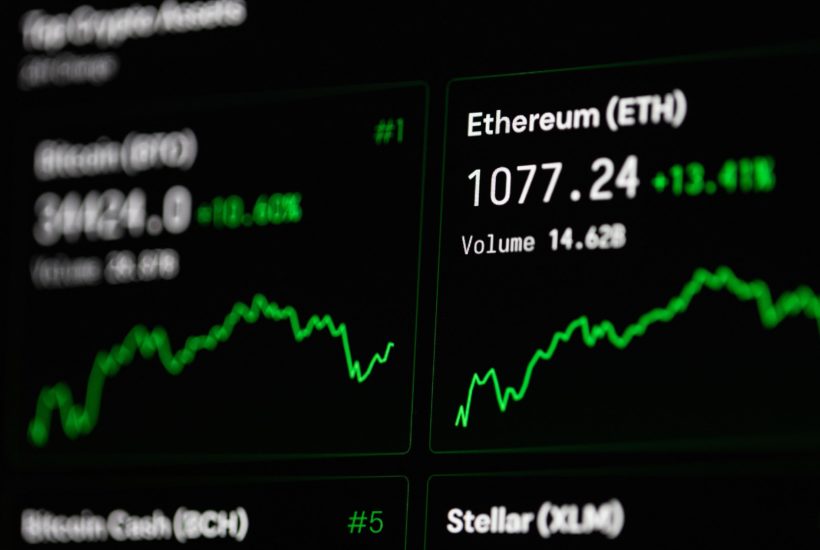Crypto
Ethereum price uptrending vs. bitcoin, while already ahead of ETH 2.0 according to Vitalik
In the podcast of Tim Ferriss, Vitalik said that ETH 2.0 developers are currently focused on the big update. At the same time, they are confident that Layer 2 solutions will support the network until Sharding is implemented. Vitalik believes rollups will suffice in the medium term. He emphasized in the podcast that rollups could improve Ethereum’s transaction throughput by 100x.

According to Vitalik Buterin, the solution to scale Ethereum 100-fold is imminent and will be a bridge until the full launch of ETH 2.0. At the same time, ETH is clearly trending upwards against Bitcoin (BTC). Is Ethereum yet to reach its prime?
Ethereum whitepaper author Vitalik Buterin believes that rollups will solve Ethereum’s scaling problems until ETH 2.0 sharding is introduced. He believes that this will allow the network to scale by a factor of 100. In addition, Vitalik predicts that a solution for Ethereum sharding will be released in the coming weeks.
Take a closer look at what this means for the Ethereum price in its valuation against Bitcoin (BTC) in the medium term and find other important financial news with our companion app, Born2Invest.
Ethereum already expects 100x scaling before sharding
In the podcast of Tim Ferriss, Vitalik said that ETH 2.0 developers are currently focused on the big update. At the same time, they are confident that Layer 2 solutions will support the network until Sharding is implemented. He stated: “Rollups will come very soon. We are fully confident that by the time we need further scaling, sharding will be ready by then.”
Rollups, for example, are those Layer 2 solutions that process and store transaction data on a particular sidechain before posting that resulting bundle of transactions back to Ethereum’s mainnet. Thus, instead of processing all transactions individually on Ethereum’s blockchain, several are bundled together, drastically reducing the actual number of transactions that take place on the first layer. Hence the name Layer 2 solution, or second-tier solutions.
Such solutions are meant to dampen Ethereum’s current scaling issues, which has led to a drastic increase in fees due to fierce competition for bandwidth on the Ethereum mainnet.
While ETH 2.0 will use sharding to ensure scalability, Vitalik believes rollups will suffice in the medium term. He emphasized in the podcast that rollups could improve Ethereum’s transaction throughput by 100x: “The thing to remember is that if you have rollups but you don’t have sharding, you still have 100x scaling, right? You still have the ability to run the blockchain at somewhere between 1,000 and 4,000 transactions per second, depending on how complex those transactions are.”
Uniswap V3 could get things started
Buterin further predicted that Optimism will launch their rollups fully compatible with the Ethereum Virtual Machine (EVM) “in about a month or so.” Optimism’s rollups are widely expected to be adopted by some of the DeFi industry leaders, with commentators speculating that Uniswap’s upcoming V3 update will use them. However, this could also mean that this means the Uniswap share price is currently heavily overbought. This is also supported by a recent UNI price forecast from the trading blog Bitcoin-Bude. Many investors are already speculating that the V3 update could come at any moment. However, the findings from Vitalik’s comments currently tend to suggest that it may not be expected in March. The crypto market is impatient by nature, but possibly Uniswap is still good for a surprise.
It is also expected that Aave and Synthetix will be among the first projects to use the technology. Vitalik also emphasized that rollups are not just a wild yet untested theory. He explained: “There have actually been simpler rollups that are only capable of processing simple transactions exchanged between assets, such as Loopring and zkSync. These rollups have been running stably for about a year – so rollups are not even theory. They’ve been a practical part of [Ethereum’s] scalability for a few users for almost a year now.”
However, to prevent silos of sorts from forming everywhere due to different Layer 2 solutions from individual projects, Buterin authored a proposal for a system that would allow smart contract protocols to communicate directly with each other across different Layer 2 scaling solutions.
Ethereum price on the rise against BTC
While a lot of noise has been made about the scaling issues on Ethereum recently and more and more market participants have been looking over to other smart contracts chains like the Binance Smart Chain (BSC), this news shows that Ethereum is by no means yesterday’s news.
At the same time, the weekly chart shows the long-term performance of Ethereum (ETH) against Bitcoin (BTC). ETH has been in a clear uptrend against BTC since early January 2020.
With fundamental breakthrough updates on the horizon, it is not far-fetched to speculate whether a cup could soon form on the chart that could take ETH back closer to a 0.08 BTC valuation or even beyond. Undoubtedly, there is still a long way to go until then (currently ETH stands at 0.032 BTC), however, there is already a clear positive trend on the horizon for Ethereum.
Many market participants are just unfortunately too focused on short-term movements and the current market clamor. A look at the medium- and long-term development of Ethereum, however, already speaks a clear language.
__
(Featured image by Bram van Oosterhout via Pexels)
DISCLAIMER: This article was written by a third party contributor and does not reflect the opinion of Born2Invest, its management, staff or its associates. Please review our disclaimer for more information.
This article may include forward-looking statements. These forward-looking statements generally are identified by the words “believe,” “project,” “estimate,” “become,” “plan,” “will,” and similar expressions. These forward-looking statements involve known and unknown risks as well as uncertainties, including those discussed in the following cautionary statements and elsewhere in this article and on this site. Although the Company may believe that its expectations are based on reasonable assumptions, the actual results that the Company may achieve may differ materially from any forward-looking statements, which reflect the opinions of the management of the Company only as of the date hereof. Additionally, please make sure to read these important disclosures.
First published in CRYPTO MONDAY, a third-party contributor translated and adapted the article from the original. In case of discrepancy, the original will prevail.
Although we made reasonable efforts to provide accurate translations, some parts may be incorrect. Born2Invest assumes no responsibility for errors, omissions or ambiguities in the translations provided on this website. Any person or entity relying on translated content does so at their own risk. Born2Invest is not responsible for losses caused by such reliance on the accuracy or reliability of translated information. If you wish to report an error or inaccuracy in the translation, we encourage you to contact us.

-

 Africa3 days ago
Africa3 days agoSurging Expenditures Widen Morocco’s Budget Deficit Despite Revenue Growth
-

 Markets2 weeks ago
Markets2 weeks agoSoybean Market Reacts to Trade Hopes, High Stocks, and Global Price Pressure
-

 Cannabis11 hours ago
Cannabis11 hours agoGermany Moves to Curb Medical Cannabis Abuse, Sparking Access Concerns
-

 Cannabis1 week ago
Cannabis1 week agoSwitzerland Advances Cannabis Legalization with Public Health Focus
























